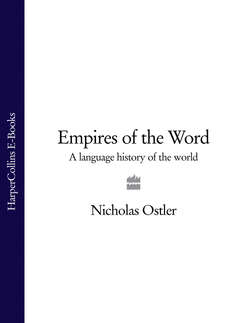Читать книгу Empires of the Word: A Language History of the World - Nicholas Ostler - Страница 26
4 Triumphs of Fertility: Egyptian and Chinese
Оглавление*
*
Zi-lu said, ‘If the Prince of Wei were awaiting you, Sir, to take control of his administration, what would be the Master’s priority?’
‘The one thing needed is the correction of names!’ the Master replied.
‘Are you as wide of the mark as that, Sir?’ said Zi-lu. ‘Why this correcting?’
‘How uncultivated you are, Yu!’ responded the Master. ‘A wise man, in regard to what he does not understand, maintains an attitude of reserve. If names are not correct then statements do not accord with facts. And when statements and facts do not accord, then business cannot be properly executed. When business is not properly executed, order and harmony do not flourish. When order and harmony do not flourish, then justice becomes arbitrary. And when justice becomes arbitrary, people do not know how to move hand or foot. Hence whatever a wise man states he can always define, and what he so defines he can always carry into practice; for the wise man will on no account have anything remiss in his definitions.’
Confucius, Lúnyû† (Analects), xiii:3 (Chinese, early fifth century BC)2
Two ancient languages, widely distant in their lands and their eras, are yet strangely similar in their careers. In their attributes they are unmatched, except by each other.
Egyptian and Chinese are both vehicles of single cultural traditions of immense prestige. For each, the role as universal language was uncontested in their homeland. By the dawn of their recorded histories they were already established over the central zone of the lands where they were to be spoken. Each maintained this position of solitary and basically unchanging dominance for an awesome period of over three thousand years, or more than 120 generations. Yet, in each case, despite the fame and prestige of the culture among neighbours, who were often dominated politically by these powers, the languages never assumed any role as lingua franca beyond the territory that they considered their homeland.
Another parallel concerns their scripts. Each language originated its own unique system of writing, based on pictograms in a particular style; and each of these scripts early attained a form that would not change. Each was later taken up by another people, and simplified to yield the basis for a phonetic writing system: Egyptian hieroglyphs were the starting point for the Phoenicians’ alphabet, and the Japanese drew their kana syllabary from Chinese characters. But in each case the original language culture disregarded the innovation, and maintained its ancient system essentially unchanged, despite the vast overhead this entailed in continuing lengthy scribal education.
Their careers are parallel. For us, their main interest lies in considering how a language can achieve steady state, a kind of homoeostasis where it appears to absorb any perturbation that might affect it. This steadiness is particularly interesting in the cases of Egypt and China, since the languages have not simply survived in isolation, but can be seen coping with human incursions for much of their history, and occupy spaces large enough to pose difficulties for a unitary government.
Another aspect of this puzzling unity, especially in the case of Chinese, is the strange coherence of the language itself. Certainly Chinese has dialects, and they are different enough often to be considered distinct languages. But this famous fact is less interesting than a less noted one: over 70 per cent of Chinese speakers speak a single variety, known as Mandarin or Pŭtōnghuà,* and this, the official language of the Chinese state, is spoken in more than 75 per cent of the country’s area. It has some local accents but essentially no internal variation. Since both the Chinese population and surface area are vast, the degree of uniformity so achieved is unparalleled in any other known language. We need to consider how it could have come about.
The two also have some direct implications for the modern world.
Egyptian, after all, did ultimately succumb to the incursions of its neighbours, carried out with steadily increasing permanence by waves of Assyrians, Persians, Greeks, Romans and Arabs, and now survives, if at all, as Coptic, in the liturgy of what was a foreign religion, Christianity. There is evidence here of what it takes to obliterate a seemingly eternal tradition in the land of its birth. How is immortality undone?
By contrast, Chinese, for all the political reverses and atrocities its people have suffered at the hands of heartless foreigners in the last two centuries, has never been stronger than it is today. Its speakers make up one sixth of the world’s population, and it has three native speakers for every one of English. Nevertheless, over 99 per cent of them live in China, so it cannot be considered a world language—unless China is your world. Those who speak it often call it zhōng guŏ huà, ‘centre realm speech’: in that at least Chinese ethnocentrism is undiminished. There is still time to consider those forces that have kept the Chinese realm so firmly, and compactly, centred on its traditional homeland: will they still prevail in the modern world?
